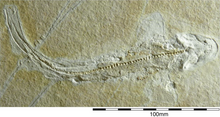| Synechodontiformes Temporal range: Early Permian-Paleogene
| |
|---|---|

| |
| Fossil of Synechodus ungeri from the Late Jurassic of Germany | |

| |
| Fossil teeth of Palidiplospinax occultidens (top) and P. enniskilleni | |
| Scientific classification | |
| Domain: | Eukaryota |
| Kingdom: | Animalia |
| Phylum: | Chordata |
| Class: | Chondrichthyes |
| Subclass: | Elasmobranchii |
| Clade: | Neoselachii |
| Order: | †Synechodontiformes Duffin & Ward, 1993[2] |
| Families | |
|
See text | |
Synechodontiformes is an extinct order of prehistoric shark-like cartilaginous fish, known from the Permian to the Paleogene. They are considered to be members of Neoselachii, the group that contains modern sharks and rays.
Their placement in the group is uncertain, some authors have considered them to be members of the modern shark group Galeomorphii, while others have considered them to represent a stem-group to modern sharks,[3][4] with some suggesting that they are basal to the last common ancestor of modern sharks and rays.[5] There is also disagreement about the relationships between Triassic and earlier members of the group, only known from isolated teeth, and those from the Jurassic onwards, with the similarity between the two groups possibly being superficial.[6]
The main shared characters of the group relate to teeth anatomy. The teeth roots have a distinctive pseudopolyaulacorhize vascularisation pattern, with a depression on the tooth root to where the nutritive grooves are confined. While Klug (2010) recovered the group as monophyletic,[4] the monophyly of the group has been doubted by other authors, who suggest that they represent a paraphyletic group.[5] One family is unambiguously placed in the order, Palaeospinacidae. The families Orthacodontidae, Paraorthacodontidae and Pseudonotidanidae, often considered members of the group, have been alternatively considered as members of the modern shark order Hexanchiformes rather than as members of Synechodontiformes.[7]
The oldest known synechodontiform remains are teeth of Synechodus antiquus from the early Permian (Cisuralian) of the Ural Mountains.[8] However, other authors have considered the attribution to the teeth to Synechodus to be questionable.[6]
- ^ "†order Synechodontiformes Duffin and Ward 1993 (elasmobranch)". Fossilworks.
- ^ C. J. Duffin and D. J. Ward. 1993. The Early Jurassic Palaeospinacid sharks of Lyme Regis, southern England. Belgian Geological Survey, Professional Papers, Elasmobranches et Stratigraphie 264:53-102
- ^ Bazzi, Mohamad; Campione, Nicolás E.; Ahlberg, Per E.; Blom, Henning; Kear, Benjamin P. (2021-08-10). Quental, Tiago Bosisio (ed.). "Tooth morphology elucidates shark evolution across the end-Cretaceous mass extinction". PLOS Biology. 19 (8): e3001108. doi:10.1371/journal.pbio.3001108. ISSN 1545-7885. PMC 8354442. PMID 34375335.
- ^ a b Klug, Stefanie (2010). "Monophyly, phylogeny and systematic position of the †Synechodontiformes (Chondrichthyes, Neoselachii)". Zoologica Scripta. 39 (1): 37–49. doi:10.1111/j.1463-6409.2009.00399.x. ISSN 1463-6409. S2CID 85265779.
- ^ a b Maisey, J. G. (April 2012). "What is an 'elasmobranch'? The impact of palaeontology in understanding elasmobranch phylogeny and evolution". Journal of Fish Biology. 80 (5): 918–951. Bibcode:2012JFBio..80..918M. doi:10.1111/j.1095-8649.2012.03245.x. ISSN 0022-1112. PMID 22497368.
- ^ a b Rees, Jan; Campbell, Hamish J.; Simes, John E. (2023-05-21). "The first Triassic elasmobranch teeth from the Southern Hemisphere (Canterbury, New Zealand)". New Zealand Journal of Geology and Geophysics: 1–8. doi:10.1080/00288306.2023.2214369. ISSN 0028-8306. S2CID 258840273.
- ^ Cite error: The named reference
:9was invoked but never defined (see the help page). - ^ Ivanov, Alexander (2005-08-30). "Early Permian chondrichthyans of the Middle and South Urals" (PDF). Revista Brasileira de Paleontologia. 8 (2): 127–138. doi:10.4072/rbp.2005.2.05.
© MMXXIII Rich X Search. We shall prevail. All rights reserved. Rich X Search
